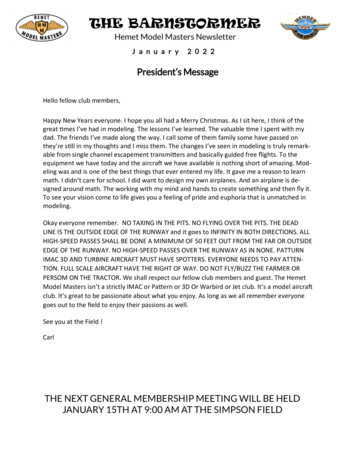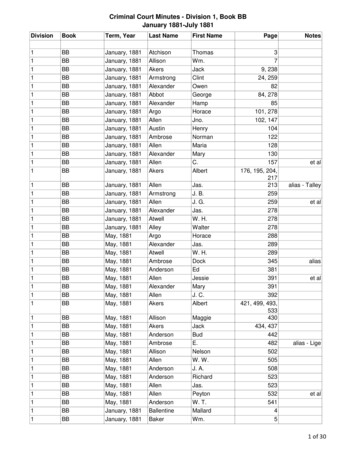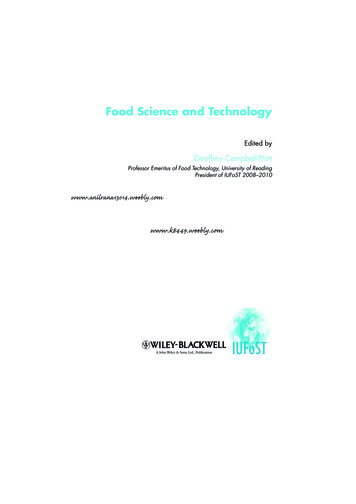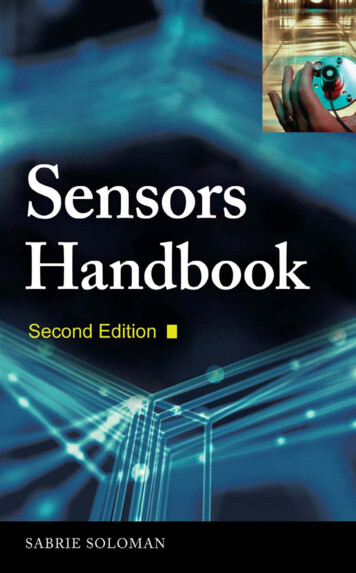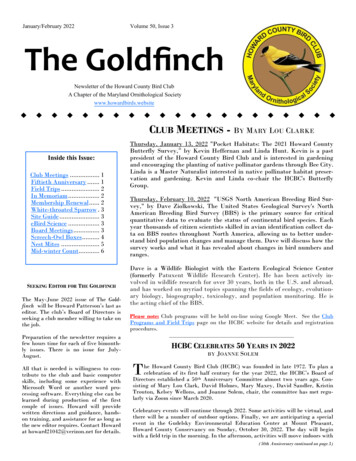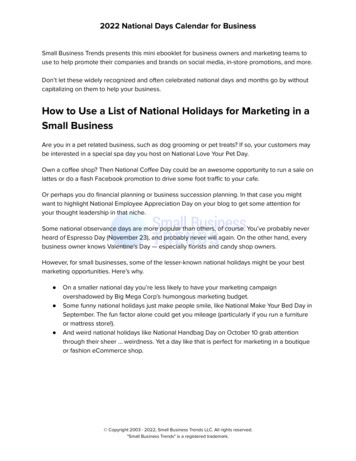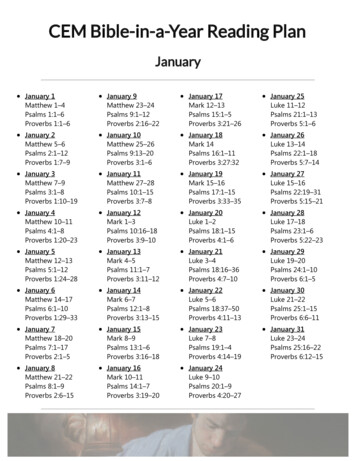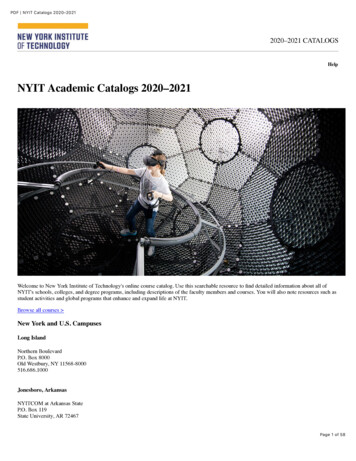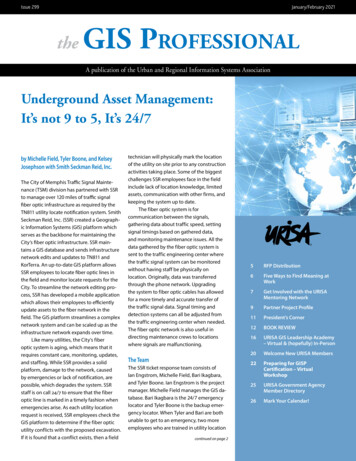
Transcription
Issue 299January/February 2021theGIS ProfessionalA publication of the Urban and Regional Information Systems AssociationUnderground Asset Management:It’s not 9 to 5, It’s 24/7by Michelle Field, Tyler Boone, and KelseyJosephson with Smith Seckman Reid, Inc.The City of Memphis Traffic Signal Maintenance (TSM) division has partnered with SSRto manage over 120 miles of traffic signalfiber optic infrastructure as required by theTN811 utility locate notification system. SmithSeckman Reid, Inc. (SSR) created a Geographic Information Systems (GIS) platform whichserves as the backbone for maintaining theCity’s fiber optic infrastructure. SSR maintains a GIS database and sends infrastructurenetwork edits and updates to TN811 andKorTerra. An up-to-date GIS platform allowsSSR employees to locate fiber optic lines inthe field and monitor locate requests for theCity. To streamline the network editing process, SSR has developed a mobile applicationwhich allows their employees to efficientlyupdate assets to the fiber network in thefield. The GIS platform streamlines a complexnetwork system and can be scaled up as theinfrastructure network expands over time.Like many utilities, the City’s fiberoptic system is aging, which means that itrequires constant care, monitoring, updates,and staffing. While SSR provides a solidplatform, damage to the network, causedby emergencies or lack of notification, arepossible, which degrades the system. SSRstaff is on call 24/7 to ensure that the fiberoptic line is marked in a timely fashion whenemergencies arise. As each utility locationrequest is received, SSR employees check theGIS platform to determine if the fiber opticutility conflicts with the proposed excavation.If it is found that a conflict exists, then a fieldtechnician will physically mark the locationof the utility on site prior to any constructionactivities taking place. Some of the biggestchallenges SSR employees face in the fieldinclude lack of location knowledge, limitedassets, communication with other firms, andkeeping the system up to date.The fiber optic system is forcommunication between the signals,gathering data about traffic speed, settingsignal timings based on gathered data,and monitoring maintenance issues. All thedata gathered by the fiber optic system issent to the traffic engineering center wherethe traffic signal system can be monitoredwithout having staff be physically onlocation. Originally, data was transferredthrough the phone network. Upgradingthe system to fiber optic cables has allowedfor a more timely and accurate transfer ofthe traffic signal data. Signal timing anddetection systems can all be adjusted fromthe traffic engineering center when needed.The fiber optic network is also useful indirecting maintenance crews to locationswhere signals are malfunctioning.The TeamThe SSR ticket response team consists ofIan Engstrom, Michelle Field, Bari Ikagbara,and Tyler Boone. Ian Engstrom is the projectmanager. Michelle Field manages the GIS database. Bari Ikagbara is the 24/7 emergencylocator and Tyler Boone is the backup emergency locator. When Tyler and Bari are bothunable to get to an emergency, two moreemployees who are trained in utility locationcontinued on page 25RFP Distribution6Five Ways to Find Meaning atWork7Get Involved with the URISAMentoring Network9Partner Project Profile11President’s Corner12BOOK REVIEW16URISA GIS Leadership Academy– Virtual & (hopefully) In-Person20Welcome New URISA Members22Preparing for GISPCertification – VirtualWorkshop25URISA Government AgencyMember Directory26Mark Your Calendar!
Underground continued from page 1Ian EngstromMemphis Director ofOperations; Project ManagerMichelle FieldGIS Analyst; GIS DatabaseManagerBari IkagbaraCEI Technician; EmergencyLocatorare available to answer the emergency. Those employees are LayneDawson, a Transportation Engineer, and Michael Williams, a CivilSenior Designer. Kelsey Josephson, a Civil EIT, is trained to assist withmanaging the GIS data and clearing tickets.Tyler BooneTransportation Engineer;Backup Emergency LocatorThe GIS database for TSM consists of the fiber optic line, pull boxes,cabinets, and poles. The database represents the complete networkfor traffic signal systems within the City of Memphis. The GIS database also allows SSR to create field apps that can be used to locateunderground fiber optic cable on location.To keep the GIS system up to date, SSR communicates withother engineering firms and Construction, Engineering, andInspections (CEI) groups to receive plans and as-builts for the fiberoptic system. TSM also alerts SSR to any missing fiber that has beenfound or if the fiber optic GIS database is showing fiber optic cablein an incorrect area. Updates to the system happen regularly.GIS updates must be updated for each firm using the platform.Each firm’s system requires a different set of rules to functionproperly. For SSR’s system, the State Plane coordinate system forTennessee (NAD 1983 StatePlane Tennessee FIPS 4100 (US Feet)) isused. The SSR GIS database contains much more information thanis needed for TN811 and KorTerra systems. The information must beextracted separately for both TN811 and KorTerra. TN811 uses thesame coordinate system as SSR; however, KorTerra uses WGS 1984,which requires the data to be projected to that coordinate system.SSR also has a website created specifically for Traffic SignalMaintenance that allows them to download their data as well as viewTicketing SystemThe ticketing system is the TN811 Positive Response Portal (Figure 1).Excavators call TN811, and TN811 gathers this information, processesit using their GeoCall Ticket/Mapping system, and notifies underground utility operators that may have utilities in the area. The utilityowners “then send personnel to locate and mark/identify theirutilities” (TN811). TN811 sends the emergency tickets to both SSR’sregular emergency ticket e-mail, as well as their backup emergencyticket e-mail.Traffic Signal Maintenance also uses a company called KorTerrato send them the tickets from Positive Response. KorTerra uses asoftware called KorWeb which analyzes the GIS data to determineif a normal, or standard, ticket is in conflict. If the ticket is clear, thesystem automatically closes out the ticket as clear – no conflict.GIS Database and Location IntelligenceSSR uses Esri products for their GIS, as they are a Bronze Esri Partner.Figure 1: TN811 Positive Response Portal Example.2
Underground continued from page 2Figure 2: The picture on the left is the transmitter, while the picture on the right is the receiver.Figure 3: From left to right: The field app showing pull boxes, fiber optic lines, and emergency locates on a street basemap; the field app with an aerial basemap; the field app showing a previous emergency ticket and where it was located.thinks the wire is everywhere. If the gain number is too low, it cannot locate the tracer wire. Upon achieving a proper gain number, thefield technician walks in the direction indicated by the receiver. Thereceiver lets the technician know which direction to walk by displaying arrows that indicate the direction of the fiber optic cable. If thereceiver displays arrows on the left and right, the technician knowsthat they are in the middle of the fiber optic cable location and theypaint an orange line on the ground to locate the cable so that it canbe avoided during excavation activities.the fiber map and a map showing all the current locate emergencies.The LocatorThe locator currently in use is the Schonstedt XTpc (Figure 2). Thispipe and cable locator connects to the tracer wire which allows afield technician to follow the fiber line above ground. The procedurefor using the locator to find tracer wire is as follows: First, the lid isremoved from the pull box. The positive wire from the transmitteris then attached to the tracer wire. Occasionally, the tracer wiremust be stripped to get contact. Next, the negative wire is grounded. Grounding can be achieved by attaching the negative wire toa ground rod in the kit, a bolt head inside of the pull box, or to aground wire on a nearby utility pole. The better the grounding connection, the better the accuracy of the trace will be. Once the wirehas been grounded, the transmitter is activated. When the transmitter is reading the tracer wire properly, the XTpc receiver is activated.The receiver displays the gain number. If the number is too high, itEmergenciesEmergencies can occur at any time. Emergency locates are instigatedby a litany of causes which include, but are not limited to, downedpoles, a contractor digging in the wrong area, or a natural disaster.An SSR field technician is on call 24/7. Whenever an emergency tickcontinued on page 43
Underground continued from page 3field app displays the location of the fiber optic lines, pull boxes,and cabinets. When on site to perform a utility location, fieldtechnicians can view the map to orient themselves. Tracer wiresare located within the pull boxes, so the first task is to locate a pullbox. Once the tracer wire is located inside the pull box, it is used toguide the painted markings used by construction crews to avoidthe fiber optic line during excavation. To close out a site visit, theapp is used to mark the location of the site visit, take pictures ofthe painted markings on the ground, and enter the ticket numberassociated with the emergency. This provides documentation of thecompleted utility locations in the field (Figure 4). These updates areautomatically uploaded to the online map upon completion. Thefinal step for a site visit is closing the emergency ticket in the TN811Positive Response portal.et is issued , the field technician has two hours to determine if thearea indicated in the emergency is in conflict or if it is clear, and, ifit is in conflict, to go to the site and physically mark the location ofthe fiber optic cable. There are several subcategories of emergencytickets. These ticket subcategories are short notice, emergency impending, and emergency. Short notice tickets are submitted with alocate deadline that occurs before the 72 hours allotted for standardtickets to be located. These tickets are requested by the caller to belocated before the specified date and time on the ticket. Emergencyimpending tickets are submitted with a locate deadline that occursbefore the 72 hours allotted for standard tickets. These tickets mustbe located by law before the specified date and time on the ticket.Each ticket marked with one of these categories is sent to the emergency ticket e-mail and must be located within two hours of receiving the e-mail, by law.Challenges with LocatingThe Field AppThe biggest challenge that field technicians face is the lack of a tracer wire in a pull box. The tracer wire allows the field technician to follow the underground utility line while painting the ground. At a sitewithout a tracer wire, SSR notifies the excavator that they are unableto locate the line. Another issue occurs when the field technicianfollows tracer wire for another utility. For example, field technicianshave followed fiber optic tracer wire to a telephone pull box insteadof a traffic signal. Gaining access to the pull box is not always easy.Sometimes pull boxes are buried or sodded over; sometimes they’refrozen shut; they have also been found with concrete over the boltThe field app used by SSR is an Esri product called Collector (Figure3). Collector is used to upload a survey from the Esri Survey123 app,which, in turn, is used to answer specific questions about the emergency. The Survey123 app is then integrated into the Collector app.The Collector app allows the field technician to see their positionrelative to the fiber optic line and pull boxes. The app can be adjusted to show street names or aerial imagery, whichever is most convenient to help the field technician locate pull boxes.The field app is used to determine if an area is in conflict. TheFigure 4: The field app showing a previous emergency ticket and the attached photos for documentation.4
Underground continued from page 4system of information. This information allows construction activities to occur within the City without causing damage to the fiber optic cable system used to operate a complex system of traffic signals.heads. In the past, field technicians have had to use the field app inorder to find the pull box. Shovels are a tool that is sometimes necessary to locate buried pull boxes.Some tickets that come through TN811 do not have thecorrect address on the ticket. In these cases, SSR field technicianshave used the latitude/longitude to determine the location of theemergency locate. Sometimes tickets describe certain buildings,but those buildings cannot be found. In these instances, GoogleMaps has been used to find the nearest building matching theticket description and determine if that is the area described by theexcavator on the ticket. Some tickets will say, “Locate at the whitepaint,” but there is not real-time imagery to see where the whitepaint is. This can make it very difficult to determine if an area is inconflict. In these situations, it is necessary to drive to these sites toview them in person. Sometimes an emergency will be at a specificproperty, but it does not say where the emergency is. There can befiber optic at that property, but if the emergency is on the other side,the field technician will not know until they arrive on site to view it.About the AuthorsMichelle Field serves as the Geographic Information Systems (GIS) Analyst for SSR. In this role,she has integrated geospatial tools and locationintelligence for SSR’s Memphis, TN office and isadvancing innovative GIS technologies throughout the company. Michelle also serves on theUrban and Regional Information Systems Association’s VanguardCabinet of Young Professionals and the Memphis Area GeographicInformation Council’s Board of Directors. She received her Master ofScience in Earth Sciences at the University of Memphis in 2019 and isboth Esri and FAA Part 107 certified.Tyler Boone is a Transportation Engineer for SSRin the Memphis, TN office, and is a licensed PE inthe state of Tennessee. In this role, he has workedin both construction and design. He received hisBachelor of Science in Engineering from UT Martin in 2010 and is FAA Part 107 certified.ConclusionMaintaining over 120 miles of traffic signal fiber optic infrastructurefor The City of Memphis requires constant care, monitoring, updates,and staffing. SSR provides a solid platform and maintains an on-callstaff 24 hours a day, 7 days a week to ensure that the fiber opticline is marked in a timely fashion when emergencies arise. SSR alsomaintains a GIS database and sends infrastructure network edits andupdates to TN811 and KorTerra, providing a consistently updatedKelsey Josephson is a Civil EIT for SSR in theMemphis, TN office. In this role, she assists withdesign for Structural, Civil Site, and Transportation projects. She graduated in 2018 with aBachelor of Science in Civil Engineering from theUniversity of Memphis.GIS TRAINING EXPRESSProfessional GIS TrainingAcknowledgements Thank you to Jeff Karafa for editing this article. Without you, this article would not be possible.in our Seattle facility or at your siteKing County GIS CustomClasses Created and taughtby working GIS professionals.GIS CertificationInstitute QualifiedEarn GISCI points.GIS Academy at KingCounty, “Beyond the Basics.”Veteran’s GI Bill BenefitsSelected programs of study atthe King County GIS Center areapproved for those eligible toreceive benefits under Title 38and Title 10, USC.Expert ArcGIS TrainingOur teachers are Esri CertifiedDesktop Associates andCompTIA Certified TechnicalTrainers.URISA’s PacificNW EducationCenterAbout Smith Seckman Reid, Inc.Smith Seckman Reid, Inc. (SSR) is an employee-owned corporation,headquartered in Nashville, Tennessee. Our firm is focused on providing engineering, commissioning, and technology services acrossthe United States and around the world. Our quality services arebased on the in-depth experience and expertise of our staff.GIS training for federal, state,local, and tribal governmentemployees in partnership withthe Washington StateDepartment of EnterpriseServices.RFP DistributionURISA members, remember thatURISA will distribute your RFP/RFQannouncements to our corporate andbusiness members at no charge. Simplyemail your announcement to info@urisa.org (Subject: RFP Service) andwe’ll send it right out for you!We help you putGIS to gis/training5
Five Ways to FindMeaning at WorkBy Dr. Maria Church, CSP, CPCSometimes work seems like, well, it’s work. It’s not the fun, fulfilling,or rewarding kind of work that we look forward to tackling but thelife-sucking, drudgery kind of work. What to do when work drainsthe soul and seems like a waste of a life? Find the meaning in thework you do and you will find meaningful work.Finding meaning is like building a bridge from one shore toanother. It is a connection of two places – where you currentlyare and where you want to be. You’re spanning a river of variouschallenges that can impede your efforts. The following five steps willhelp you build the bridge to find meaning at work:photography, but that may not be required for your job. Chances arethat someone in the organization my need some photographs takenfor a project they are working on, employee badges, annual report,or many other possibilities. Let key contacts within the organizationknow that you have this skill and would love to help out.You will not only get to do something you love at work, but youget the added bonus of helping as well – a win-win!4. Take a BreakSometimes you just need to walk away for a little while. After all, “absence makes the heart grow fonder.” Vacations are designed to givea break, refresh the mind, and replenish the soul. Take your vacations! If you need to take a day to do a mini-vacation to refresh andrejuvenate, then do so. While you are at it, take your lunch break too,and a mid-morning or mid-afternoon break to walk around outsideand take in some fresh air.Burnout happens when we don’t take those mini-breaks andlonger respites from work. Oftentimes when you just keep pluggingaway at work, you could lose concentration and focus. This practiceis extremely unproductive in the long run. You are not the EnergizerBunny! Feed your soul with a break from work.1. Find Your “Why”Everyone has a “why” they work and it just gets buried in the day-today grind. Remember when you applied for the position in the firstplace? The excitement and anticipation you had filling out the application and sending it off with your resume? Remember the endlesswaiting for the invitation to interview and the nervousness you feltwhen you interviewed? Why were you so excited, anxious, and nervous? Why did you want that job? What was it about that organization or position that excited you so? This was your why! Connectingwith your why may be as simple as answering these questions andfeeling your response.Your why might be the prestige of the position, or the challengeof the projects. Your why might be because it is a great companywith a mission or vision of which you wanted to be a part. Or, yourwhy could be the salary and benefits the position provided you.Your why could have been to take care of your family or travel more.Whatever that is, reconnect with it. If your why has changed, thenbuild the bridge to your new why.5. Be AuthenticIt is exhausting trying to be someone else – the person your bossthinks you should be, the team member your colleagues think youought to be, or the super-worker you think you should be. Be YOU.When you live and work in a place of authenticity, you tap into yourown creativity, joy, and meaning.Remember that meaningful work is just a bridge away. You canreconnect anytime you stop, pause, and remember what broughtyou here in the first place.2. Help SomeoneIf you want to find meaning, try helping someone else. Humans arehelpers, it is in the DNA. Winston Churchill said, “We make a living bywhat we get, we make a life by what we give.” Helping others takesthe focus off yourself and puts it onto another.Not only will it help you focus on someone and somethingelse than hating your job, it will also feel darn good while you areat it. Perhaps you could mentor someone, or give a tour to a newemployee. You could volunteer for a committee and meet some newpeople in the organization at the same time.About the Author:Dr. Maria Church, CSP, CPC, is a speaker, consultant, and executive coach. As CEO of Dr. MariaChurch International, including Governmentand Corporate divisions, and Leadership Development University, she specializes in organizational culture, change agility, and leadershipdevelopment with over 25 years working forFortune 500, local government, non-profit, and academia. Her 10thAnniversary Edition of Love-Based Leadership will be released in December 2020. She may be reached at www.DrMariaChurch.com.3. Leverage Your SkillsWhen you leverage your skills with what you enjoy doing, you arebridge-building a task with meaning. For instance, you may enjoy6
Get Involved with theURISA MentoringNetwork to the relationship bycommunicating their ownexperiences and observationsof the latest industry trends,software knowledge, andinnovative approaches togeospatial problem solving.The success of this program depends on the amount of workput in by each mentor-mentee pair. It is expected that mentors andmentees dedicate at least two to five hours a month to this program.Your relationship with your mentee does not have to end at the endof your term. We hope that mentors and mentees will develop astrong relationship that will last for years to come.There is no age or experience requirement to be a mentor, soif you are ready to kick off your mentorship journey, get involvedtoday!Are you passionate about your field and interested in helpingothers identify their passions?Are you willing to share your skills, knowledge, and expertise?Do you value continued education and growth?Are you a good listener?Can you spend two to five hours a month cultivating ameaningful and rewarding relationship?If you answered yes to any of these questions, you would make agreat mentor in The URISA Mentoring Network!Think back to when you first entered the job market. Whatdo you wish you had known? What advice do you wish had beenshared with you? You have the opportunity to pass your wisdom andexperience on to emerging professionals in the geospatial industry.Last year, the URISA Vanguard Cabinet launched the URISAMentoring Network to foster strong connections betweengeospatial professionals at all stages of their careers. The VanguardCabinet strongly believes that mentorship is one of the mostpowerful ways to expand your social network, trade insights withanother professional in your field, and stay on top of the latestindustry trends. The mentoring program aims to improve theacademic and professional achievements, self-esteem, and technicalcapabilities of geospatial professionals within our industry. Theprogram consists of three cohorts annually and relies on volunteersto mentor our emerging professionals.During the application and matching process, we considerthe mentor and mentee’s experience and goals to create the mostsuccessful mentor/mentee pair. After a prospective mentee ismatched with a mentor, each pair is expected to meet monthly. TheMentoring Program provides resources for each mentor-mentee pairto guide their discussions. Each mentor can support their menteeby sharing their own career journey, suggesting helpful training orcertifications the mentee might pursue, providing a sounding boardwith a different perspective, and building their mentee’s network byintroducing them to other practitioners in the field.Traditionally, mentorship is viewed as something that requiresa mentor to be older or significantly more experienced than thementee. While we view mentorship as a key factor in the growth anddevelopment of young and emerging geospatial professionals, wealso believe that the most successful mentor-mentee relationshipsare an exchange of ideas and perspectives. We acknowledge thatwe can all learn from each other, regardless of age or years ofexperience. Our criteria for mentors are not based on age, but ratherone’s willingness to offer support to other geospatial professionals.Furthermore, we encourage each mentee to proactively contribute“Each of us has likely had one or more mentors who have made apositive impact through their advice, willingness to listen and encouragement. I think that one of the most meaningful contributions we canmake as professionals is the sharing of our knowledge and experiencewith others. I am really pleased that URISA’s Mentoring Network provides an opportunity for us to support one another in this way.”- Kevin Mickey - URISA PresidentFrequently Asked Questions:When is the next deadline to apply?Applications for Cohort #1 closes on February 15. The applicationdeadline for Cohort #2 will close on May 15th.I know other professionals that would be great mentors, butthey aren’t URISA members. Can they still sign up to be a mentor?You do not have to be a member to participate in the URISA Mentoring Network!What is the monthly time commitment and duration of theprogram?The minimum expected time commitment is two to five hours permonth. Each cohort is six months long.How can I get involved?Visit our website for more information and to sign up today!7
the board. A huge factor we consider is what I call “Plays well withothers”. This does not mean we are looking for a passive individualthat goes along with what others say. Quite the contrary. We wantpeople with strong ideas and a desire to make things better, butacknowledging the reality that they will not always win their side ofthe argument. The current board is a great example of this. We allcome from many sides of the profession, and at times disagree verystrongly with a particular position. But, in the end, we all know weare heard and have worked hard to come to a unanimous decision.It is crucial that incoming board members are prepared to workwithin that type of environment. The current LDC has worked hardto recommend a slate of candidates that we believe will serve URISAwell in the next 3 years.Next up, the Vanguard Cabinet! Service on the VanguardCabinet (the VC) is similar to the Board of Directors in that it is a3 year commitment. And in this case, instead of an election, VCmembers are chosen through an application process. Much of thecriteria we examine for a Board member is the same for the VC. But,of course, all of the applicants are part of our dynamic group ofyoung professionals. This is one of the hard, but fun responsibilitiesfor the LDC. This is a motivated and energetic group and we haveprovided a venue for them to get involved. You will notice a patternover time that the Board of Directors has one or more formermembers of the VC on it, and that is intentional. This is one, but notthe only, group we have set up to develop leaders.Finally, the last job the LDC – and - another fun activity of thiscommittee - is to select the Young Professional of the Year. In thiscase, the LDC is provided a list of candidates from the VanguardCabinet and based on some of the same criteria listed above, makesa selection. And, once again, you will likely see former YP’s of theyear on future boards.So, hopefully it is obvious that the Leadership DevelopmentCommittee is more than just another nominations committee. Thisgroup truly is working to assure that URISA has a pool of capable andinnovative leaders for many years to come. Our goal is to ensure ourlegacy.This column will be a regular feature in the GIS Professional andwill highlight the various URISA committees.In this edition of the Committee Column we focus on the LeadershipDevelopment Committee (LDC).You may very well have not heard of the Leadership DevelopmentCommittee, or LDC for short. For those that are familiar with it, youmay be of the belief that it is essentially another name for a nominations committee. And, you would partially right. But the LDC hasadditional responsibilities that indeed shape the future leadershipof URISA.First off, who serves on the LDC? The Leadership DevelopmentCommittee is chaired by the Immediate Past President. TheLDC chair will then ask several URISA members to serve onthe committee. It is the prerogative of the chair to choose thecommittee members and make the committee as complex, or assimple as they wish. The LDC then has 3 basic tasks. First, select aslate of candidates for Board of Directors and President- elect torecommend to the current board of directors. Second, select newmembers of the Vanguard Cabinet based on a review of applicationsand third, select the Young Professional of the Year based onrecommendations of the current Vanguard Cabinet.The duties of the LDC are spaced throughout between GISPro conferences. The first thing the committee is responsible foris indeed developing a slate of candidates for President and theBoard of Directors. This is no small task. The committee maintainsa list of potential candidates that we select from, at least initially,to build a slate. How does one get on this list? The primary wayis to get involved. We look for people that have a history of notonly being active in URISA particularly, but in their profession ingeneral. We look for people that have volunteered to lead and thathave stepped forward when things need to be done or said. Theyhave demonstrated that they want to make a difference. You canalso get on the list of potential candidates by simply asking. Thissort of initiative is welcomed. But, know that we will also look atall the previously mentioned criteria when considering anyonefor the Board. As we assemble our slate of candidates, we also
regular emergency ticket e-mail, as well as their backup emergency ticket e-mail. Traffic Signal Maintenance also uses a company called KorTerra to send them the tickets from Positive Response. KorTerra uses a software called KorWeb which analyzes the GIS data to determine if a normal, or standard, ticket is in conflict. If the ticket is clear, the
